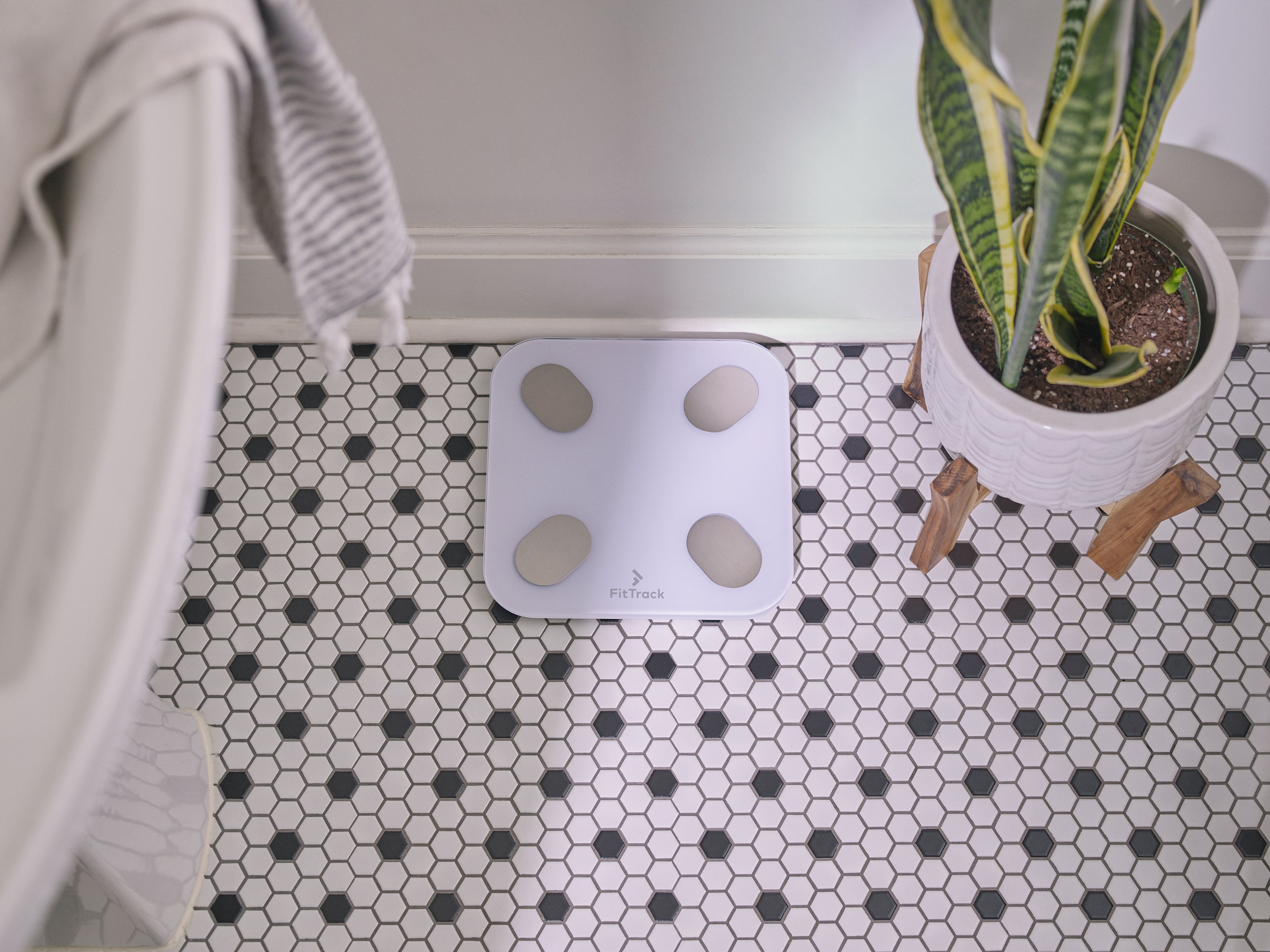Muscle or Fat- What Weighs More?
If you know of any fitness fanatics, you’ve probably heard the phrase about how a pound weighs more than a pound of fat. Sure, it sounds authentic and maybe even motivational, but experts debunk this claim, explaining that it holds no truth. Whether it is a pound of a glass or a pound of a feather, the pound remains a pound.
Nevertheless, muscles are indeed denser in contrast to fat. They occupy less volume in the body than the same amount of fat does. This is a major reason many people look slimmer but haven’t shed any pounds even though they’ve lost a considerable amount of fat.

Knowing your lean muscle mass can help you adjust your calories. See how the FitTrack Dara Can Help.
Reversibly, the effect is even more prominent in older adults. It is because muscles start shrinking as you age. Plus, your body's cell repair system for damaged muscle cells works at a significantly slower rate.
That means, if you see your parents or grandparents reducing muscle density, it is not just an illusion. It might be the effects of chronic conditions such as diabetes or any other medical issues.
So if you're vigorously working out to lose weight, but the figures on your scale don’t fall, you’re probably wondering why. If that’s the case, continue reading to explore more about this one of the most debated topics.
Myth Debunked- Here is the Truth
As mentioned above, if you're trying everything to lose weight, get in shape or switch to a healthier lifestyle, you’re probably relying on the scales to tell you the difference.
You're eating healthy, doing your resistance training, meditating, following a nutritional diet plan from the best nutritionist, and participating in sports. But if the weighing scale doesn't show a significant difference, there is no need to lose hope.
Keep in mind that not losing weight on a weighing scale doesn't mean you’re no closer to achieving your fitness goals. In fact, it happens because muscles are denser than fat.
Fat vs. Muscle

Did you know one cup of fat weighs 7.5 oz, one cup of muscle weighs 9.7oz, and an equal volume of fat weighs about 80% of total muscle weight?
Remember that pounds have different structures and tendencies. Don't rely on your weight to determine your look and health risks you might encounter. You may find two individuals with the same body mass but with different percentages of muscles and fat.
That means if you put on an extra fat (25 pounds), you may look chubbier with a less toned appearance. However, gaining the same amount of muscles can make you look toned, sculpted, and firm. Moreover, both muscles and fats serve different functions.
Fat aids the insulation process in the body. Typically, it fuels the body by trapping in body heat.
Muscles, on the other hand, are a metabolism booster. When you gain more muscle than fat, you will burn more calories when your body is resting. That is to say, and even if you're not working out or sitting on a couch, you're burning more calories when you have more muscle. It not only helps you lose fat but makes you look leaner. That is why your personal trainer or dietitian often emphasize weight gain by working on muscular exercises.
Having more muscle mass or building muscles can also help improve bone density and BMI. It prevents loss of muscles, enhances muscle density when you age, and helps you stay active. When you reduce fat and make muscles, you might get slimmer and heavier at the same time. You might fit in the clothes without losing pounds on the weighing scale.
BMI (Body Mass Index) and Muscle - What is the Connection
The key determiner of your BMI (body mass index) is not your body's composition but your height and weight. A bulk of evidence has shown that the relationship between your body's fat and the value derived from your height and weight is moderate. Plus, one study shows that it can accurately predict various outcomes of medical illnesses, including hypertension and diabetes.
Healthy Body Fat Percentage - (Lean-to-Fat Ratio)
Based on your age and gender, you can have different body fat percentages. Many recent studies have shown that people with higher fat tissue have a higher death ratio, regardless of their BMI. It is because the fatter your body has, the higher the chances of developing conditions like;
- Heart disease
- Hypertension
- Diabetes
That means even if you're slim but have a low muscle-to-fat- ratio, you are at risk of developing diseases related to obesity. Keeping your body’s fat percentage low is essential.
And if you don't experience immediate changes in your body mass, do not lose motivation. Try focusing on the long-term results that will give you're the permanent results.
How to Measure Your True Body Composition
As mentioned above, excess fat often contributes to health conditions such as stroke, diabetes, and heart disease.
It may also lead to developing diseases like cancer. It is always better to talk to your medical professional about your ideal body composition to promote overall health.
Meanwhile, remember that everyone has a different bodyweight with different composition. You can consult your personal trainer to find your healthy weight. He may suggest sports medicine to help you improve your body composition.
Here is a rundown of what percentage of muscles and fat is correct for you.
Smart Scale
Smart scales like the FitTrack Dara can help you obtain your bone, fat, muscle, and water in the body. You may find BMI, water weight, bone mass, muscle weight, Basal Metabolic rate using this smart device.
It can also measure your heart rate and pulse wave velocity. It is, without a doubt, a fantastic indicator of your cardiovascular health and overall wellness. You must have it if you're doing weight training.
Measuring Tape
Measuring your progress using a body measurement tape will give you a glimpse of your fitness journey. You can do it every four to six weeks at any time that suits you the best.
All you need is to fetch your measuring tape and note down stats on your phone. Here is what you can measure with your measuring tape.
- neck biceps
- hips/butt
- thighs
- waist (for women)
- stomach (widest part)
- calves
- thighs
You can ask your friend to help you measure the trickier parts like biceps.
Body Fat Percentage
Don't want to share fat specifics of your body with anyone? Purchase a personal body fat scale to find the percentage without having to go anywhere.
Calipers are another practical method you can use to measure body fat percentage.
Your trainer may also use a fat analyzer machine that sends current through the body to find the fat percentage.
The speed of signals depends on how much fat does your body has. The signals travel slowly if the fat rate is high. Your body's hydration level and accuracy of the device are also two important factors to consider.
Mirror Check
How you feel by looking at yourself is also a way to measure the results. It is a relatively older method and is less precise. You can notice the difference if your clothes don't fit you anymore.
Keep in mind that physical strengthen is not your only success. You can celebrate the smaller milestone by keeping a personal record.
Sleep Effects the Scale
Family gatherings, office parties, late-night singing songs with loved ones on Zoom, regardless of the reason behind your late sleeping hours, low or less sleep can affect your weight loss journey.
A poor sleep cycle may alter your leptin and ghrelin levels and increase your appetite.
You must schedule your sleeping hours and take enough rest even if you need to compromise the activities you enjoy doing.
For instance, don't plan an early morning workout on weekends if you plan to stay up late in the night. Know that everything is in your control if you plan smartly.







